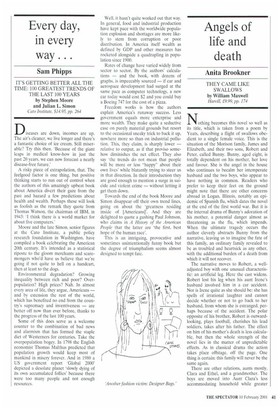Every day, in every way . . .
Sam Phipps
ITS GETTING BE 1 1ER ALL THE TIME: 100 GREATEST TRENDS OF THE LAST 100 YEARS by Stephen Moore and Julian L. Simon Caw Institute, $14.95, pp. 264 Diseases are down, incomes are up. The air's cleaner, we live longer and there's a fantastic choice of ice cream. Still miserable? Try this then. 'Because of the giant leaps in medical know-how in just the past 20 years, we can now forecast a nearly disease-free future,'
A risky piece of extrapolation, that. The feelgood factor is one thing, but positive thinking starts to run out of control when the authors of this amazingly upbeat book about America divert their gaze from the past and hazard a few predictions about health and wealth. Perhaps these will look as foolish as the remark they quote from Thomas Watson. the chairman of IBM, in 1943: 'I think there is a world market for about five computers.'
Moore and the late Simon, senior figures at the Cato Institute, a public policy research foundation in Washington, have compiled a book celebrating the American 20th century. It's intended as a statistical riposte to the gloom merchants and scaremongers who'd have us believe that we're going if not quite to hell on a handcart, then at least to the dogs.
Environmental degradation? Growing inequality between rich and poor? Overpopulation? High prices? Nah. In almost every area of life, they argue, Americans — and by extension the rest of the world, which has benefited no end from the country's supremacy and inventiveness — are better off now than ever before, thanks to the progress of the last 100 years.
Some of this does serve as a welcome counter to the combination of bad news and alarmism that has formed the staple diet of Westerners for centuries. Take the overpopulation bogey. In 1798 the English economist Thomas Malthus predicted that population growth would keep most of mankind in misery forever. And in 1980 a US government report 'Global 2000' depicted a desolate planet 'slowly dying of its own accumulated follies' because there were too many people and not enough resources. Well, it hasn't quite worked out that way. In general, food and industrial production have kept pace with the worldwide population explosion and shortages are more likely to stem from corruption or poor distribution. In America itself wealth as defined by GDP and other measures has rocketed alongside a quadrupling in population since 1900.
Rates of change have varied widely from sector to sector. By the authors' calculations — and the book, with dozens of graphs, is impeccably sourced — if car and aerospace development had surged at the same pace as computer technology, a new car today would cost $2 and you could buy a Boeing 747 for the cost of a pizza.
Freedom works is how the authors explain America's runaway success. Less government equals more enterprise and more wealth. They make quite a seductive case on purely material grounds but resort to the occasional sneaky trick to back it up, nowhere more so than on industrial pollution. This, they claim, is sharply lower — relative to output, as if that proviso somehow diminishes the net effect. They also say 'the trends do not mean that people will be more or less "happy" about their own lives' while blatantly trying to steer us in that direction. In their introduction they are good enough to mention a surge in suicide and violent crime — without letting it get them down.
Towards the end of the book Moore and Simon disappear off their own trend lines, going on about the 'greatness residing inside of [Americans]'. And they are delighted to quote a gushing Paul Johnson, who claims in A History of the American People that the latter are 'the first, best hope of the human race'.
This is an intriguing, provocative and sometimes unintentionally funny book but the degree of triumphalism seems almost designed to tempt fate.


































































 Previous page
Previous page